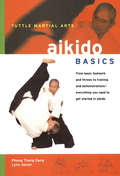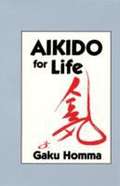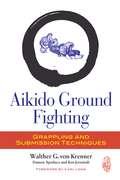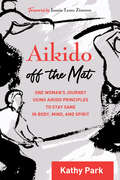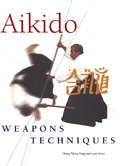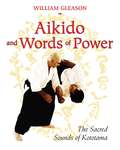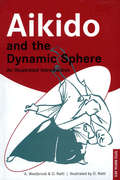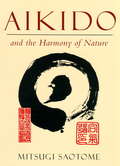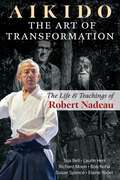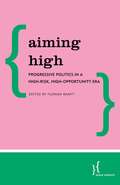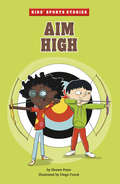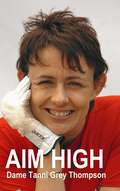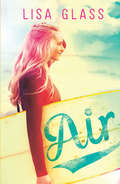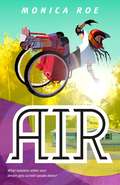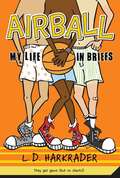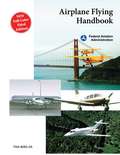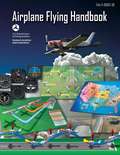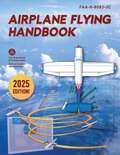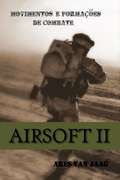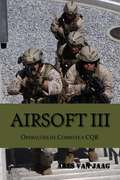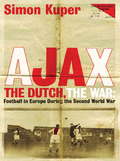- Table View
- List View
Aikido Basics
by Phong Thong Dang Lynn SeiserIn Aikido Basics, the beginning student will find invaluable advice and information for the study of this popular form of martial arts. Martial Arts Hall of Fame inductee, Dang Phong, shares his secrets to building a successful training program, testing for belt promotion, and understanding and developing Ki, the energy used in aikido. The author incorporates a discussion of aikido's origin, its history and philosophical underpinnings, and an explanation of the different branches of aikido.
Aikido For Life
by Gaku HommaA teacher's guide for instructing beginners of Aikido--this book appeals to the new beginner and experienced student alike. Nippon Kan was established in 1980 as a center for Denver residents to experience Japanese culture. The center has since served more than 6,000 students with its variety of classes, but its core is still Aikido. Thousands of students have benefitted from Gaku Homma's form of dynamic Aikido.
Aikido Ground Fighting: Grappling and Submission Techniques
by Carl Long Walther G. Von Krenner Ken Jeremiah Damon ApodacaAikido Ground Fighting presents effective ground techniques that remain true to aikido founder Morehei Ueshiba's teachings while addressing a potential weakness in the system: while aikido is renowned for its submission and compliance techniques as well as grappling from a standing position, it is not known for its effectiveness when it comes to ground fighting. Aikido Ground Fighting is a unique look at the roots of aikido techniques (in particular, the kneeling practices of suwari-waza) and how they might be applied to defense on the ground. Written by a direct student of Morihei Ueshiba in collaboration with other aikido teachers, this book remains steadfastly true to the founder's teachings while presenting innovative and effective techniques. Containing never-before-published pictures of Ueshiba as well as step-by-step photographs clearly demonstrating techniques, Aikido Ground Fighting is designed for aikido students looking to become more well-rounded martial artists as well as practitioners of all martial arts seeking effective self-defense techniques.From the Trade Paperback edition.
Aikido Off the Mat: One Woman's Journey Using Aikido Principles to Stay Sane in Body, Mind, and Spirit
by Kathy Park Jamie Leno ZimronA deeply personal and compelling memoir that illustrates how the basic principles of Aikido can help us cope with the challenges of life outside the dojoDrawing from more than forty years of experience as an Aikido practitioner and teacher, Kathy Park explains how principles such as embodiment, grounding, centering, extension, 360-degree awareness, blending, and alignment can be applied to everyday life. Candid stories from her own life show how the purpose of practicing Aikido on the mat is to take it off the mat and into the world.
Aikido Weapons Techniques
by Phong Thong Dang Lynn SeiserThough aikido is known as a nonviolent, noncompetitive martial art, the use of weapons in aikido was introduced by the art's founder O'Sensei Morihei Ueshiba.The wooden weapons of aikido are most often used as training tools to better illustrate aikido principles and movements and to train in self-defense against weapons. This book features the three main weapons used in aikido: the boken or ken (wooden sword), jo (wooden short staff), and tanto (wooden knife). A complete discussion on each weapon is included with descriptions of the stances, grips, techniques, defenses, forms, and training appropriate for each weapon.The aikido concepts, training and techniques represented are those influenced by the weapons practice of O'Sensei Morihei Ueshiba, as well as the styles of Saito Sensei's Iwama-ryu.
Aikido and Words of Power: The Sacred Sounds of Kototama
by William GleasonFor the first time in English, the secrets of the sacred sounds that unlock the principles and spiritual strength of aikido• Explains the nature of the five vowels that govern the physical manifestations of universal consciousness • Uses more than 300 photographs to demonstrate a unique approach to aikido techniques that supports advanced spiritual practice• Author is a 6th dan aikido instructorAikido founder Ueshiba Morihei described the discipline as one spirit, four souls, three origins, and eight powers. One spirit and four souls are the five vowel dimensions of infinite space, the source of the sacred sounds of Kototama. Now, for the first time in English, William Gleason explains how to use the sounds of Kototama in the practice of aikido. Aikido is often approached as a purely physical discipline, but it is a truly profound spiritual vehicle for those who approach it with sincerity of purpose. The five vowels represent various dimensions and stages of awareness, whose different powers are revealed through aikido practice. Using more than 300 photographs, Gleason sensei presents physical routines that provide an introduction into the Kanagi, Sugaso, and Futonorito levels of spiritual development.Understanding the sacred sounds related to each of these dimensions, the adept gains not only the ability to realize the stages inherent in spiritual mastery but also the ability to maintain health and balance in his or her own life. “When fish move through water, there is no end to the water; when birds fly, there is no end to the sky.” Similarly, humans swim and fly in an ocean of sounds. Understanding Kototama allows human beings to view the world without distortion and allows the creative powers of the mind to flourish.
Aikido and the Dynamic Sphere
by Oscar Ratti Adele WestbrookAikido neutralizes aggression and renders attackers harmless. By controlling body position and harmonizing their vital physical and mental powers, anyone (regardless of size, strength or weight) can fend off attacks using this sophisticated martial art. This classic text reveals the secrets which enable the stunning control practiced in Aikido.
Aikido and the Dynamic Sphere
by Oscar Ratti Adele WestbrookAikido neutralizes aggression and renders attackers harmless. By controlling body position and harmonizing their vital physical and mental powers, anyone (regardless of size, strength or weight) can fend off attacks using this sophisticated martial art. This classic text reveals the secrets which enable the stunning control practiced in Aikido.
Aikido and the Harmony of Nature
by Mitsugi SaotomeHere is a unique approach to the teachings of the Founder of Aikido, Morihei Ueshiba, as interpreted by his direct student of fifteen years. Mitsugi Saotome examines the spiritual philosophy of the Founder, the warrior ideals of feudal Japan as the basis of his martial arts philosophy, and the scientific principles underlying the philosophy of Aikido technique. The author shows that the physical movement of Aikido is the embodiment of principles of the spirit. Negative force is not countered with aggression but is controlled and redirected through the power and balance of spiral movement. This is the shape of Aikido and the dynamic shape at the foundation of all energies of existence. Aikido movement can only be understood from its roots in universal law and the processes of nature. The sincere practice and study of Aikido deepens our appreciation for the perfection of nature's balance and brings us back into harmony with our environment, other people, and ourselves. Abundantly illustrated with the author's drawings, diagrams, and calligraphies, as well as photographs demonstrating Aikido techniques, the book also offers a history of Aikido, personal anecdotes about the Founder, and translations of several of his lectures.
Aikido: The Life and Teachings of Robert Nadeau
by Richard Moon Teja Bell Laurin Herr Bob Noha Susan Spence Elaine Yoder• Explores Nadeau&’s personal journey and pioneering role in the spread of Aikido, including firsthand accounts and historical photographs published for the first time• Explains Nadeau&’s unique teaching, his core concepts, and basic practices centered on energy refinement, direct experience and inner transformation• Presents inspiring personal stories about Nadeau contributed by students, including Dan Millman, Richard Strozzi-Heckler, Peter Ralston, and Renée GregorioA widely influential figure in the development of Aikido in America, Robert Nadeau is known as one of the few American direct disciples of Aikido&’s founder Morihei Ueshiba Osensei. Now an 8th dan Aikido master teacher, Nadeau has taught generations of students, and several have become prominent teachers in their own right. However, he has never written about his life or philosophy, always reserving his most pointed lessons for those who practice with him in person.This book tells the story of Robert Nadeau&’s life journey and his distinctive approach to teaching Aikido as a way to access the inner energetic aspects of the art, a transformational approach with universal applications in daily life, even for non-Aikidoists. The authors explore Nadeau&’s early interest in martial arts and all things spiritual as a teenager in California in the 1950s, his seminal training under Morihei Ueshiba at Aikido Hombu Dojo in Tokyo in the 1960s, and the following six decades of training, experimenting, refining, and teaching as he worked to introduce Aikido to the wider world, even beyond the traditional dojo. They lay out Nadeau&’s core concepts, describe his simple-but-effective practices for personal development, and convey his time-tested approach to the inner training at the heart of Aikido in a very accessible way. They also include first-person accounts from Nadeau&’s students, including Dan Millman, Richard Strozzi-Heckler, Peter Ralston, and Renée Gregorio, who recall their personal experiences of training with him, retell conversations with him, and describe insights and lessons learned, sharing how he affected their lives, sometimes quite profoundly.Bringing the story of Robert Nadeau&’s life into focus, this book presents, for the first time, the profound lessons and deep impact of a pioneering teacher who&’s been central to the spread of Aikido in the West.
Aim High
by Tanni Grey-ThompsonAim High is an inspirational book written by the UK's leading wheelchair athlete, Dame Tanni Grey-Thompson. She has won 16 medals, eleven of which are gold, countless European titles, six London Marathons and over 30 world records have catapulted this Welsh wheelchair athlete so firmly into the public consciousness. Aim High reveals what has motivated her through her best and worst times.
Aim High (Kids' Sports Stories)
by Shawn PryorFriends Kerry and Zack can't get enough of their favorite superhero, a bow-and-arrow-toting character named Brave Bowie. His magic arrows always save the day. But when the friends sign up for archery lessons, they soon learn that practice and hard work make real-life archers great in the sport, not cartoon tricks.
Aim High (Quick Reads Ser.)
by Tanni Grey-ThompsonAim High is an inspirational book written by the UK’s leading wheelchair athlete, Dame Tanni Grey-Thompson. She has won 16 medals, eleven of which are gold, countless European titles, six London Marathons and over 30 world records have catapulted this Welsh wheelchair athlete so firmly into the public consciousness. Aim High reveals what has motivated her through her best and worst times.
Aim High (Quick Reads)
by Tanni Grey-ThompsonAim High is an inspirational book written by the UK’s leading wheelchair athlete, Dame Tanni Grey-Thompson. She has won 16 medals, eleven of which are gold, countless European titles, six London Marathons and over 30 world records have catapulted this Welsh wheelchair athlete so firmly into the public consciousness. Aim High reveals what has motivated her through her best and worst times.
Aiming High: Junko Tabei's Daring Climb (Fountas & Pinnell Classroom, Guided Reading Grade 5)
by Michael Love Catherine JohnFOR THE LOVE OF CLIMBING No woman had ever climbed to the peak of Mt. Everest. Dozens of men had died trying. Yet Junko Tabei decided it was time for her to face the dangers and try to reach the top. NIMAC-sourced textbook
Air: 'a Stunning Read For Summer' (Blue Ser. #2)
by Lisa GlassLast year, one amazing summer was enough to turn Iris's world upside down. She met the boy of her dreams, the super talented Zeke, and the two of them set off on a pro-surfing adventure around the globe.Now, one week in Miami could be enough to tear her life apart.When Iris and Zeke take a break from competitions to relax on South Beach, Iris feels more than just the draw of the surf pulling Zeke away from her. Something's not right, and soon Iris will have to decide if she and Zeke are really the best thing for each other after all.Air is the thrilling follow-up to Blue; a gorgeous story of sun, sea and first love.
Air: A Novel
by Monica RoeAn action-packed, empowering middle grade novel about a girl who has to speak up when her wheelchair motocross dreams get turned upside down.Twelve-year-old Emmie is working to raise money for a tricked-out wheelchair to get serious about WCMX, when a mishap on a poorly designed ramp at school throws her plans into a tailspin. Instead of replacing the ramp, her school provides her with a kind but unwelcome aide—and, seeing a golden media opportunity, launches a public fundraiser for her new wheels. Emmie loves her close-knit rural town, but she can’t shake the feeling that her goals—and her choices—suddenly aren’t hers anymore. With the help of her best friends, Emmie makes a plan to get her dreams off the ground—and show her community what she wants, what she has to give, and how ready she is to do it on her own terms.Air is a smart, energetic middle grade debut from Monica Roe about thinking big, working hard, and taking flight.
Airball
by L. D. HarkraderKirby Nickel loves basketball. The only problem is he can't play basketball. But when an opportunity to meet NBA star Brett McGrew comes up, Kirby knows he has to take a chance and try out for the basketball team. Getting on the team turns out to be easy--the rest of the boys are as supremely untalented as Kirby--but winning in order to be eligible to meet McGrew is a whole different problem. Different and embarrassing. The coach's radical new plan for success involves the boys playing in their underwear. But if this crazy idea works, Kirby will get to meet his hero--who he secretly also hopes is his long-lost father.
Airplane Flying Handbook (FAA-H-8083-3A)
by Federal Aviation AdministrationThe Federal Aviation Administration’s Airplane Flying Handbook provides pilots, student pi-lots, aviation instructors, and aviation specialists with information on every topic needed to qualify for and excel in the field of aviation. Topics covered include: ground operations, cockpit management, the four fundamentals of flying, integrated flight control, slow flights, stalls, spins, takeoff, ground reference maneuvers, night operations, and much more. The Airplane Flying Handbook is a great study guide for current pilots and for potential pilots who are interested in applying for their first license. It is also the perfect gift for any aircraft or aeronautical buff.
Airplane Flying Handbook: FAA-H-8083-3B (FAA Handbooks Ser.)
by Federal Aviation AdministrationThe Federal Aviation Administration’s Airplane Flying Handbook provides pilots, student pilots, aviation instructors, and aviation specialists with information on every topic needed to qualify for and excel in the field of aviation. Topics covered include:Ground operationsCockpit managementThe four fundamentals of flyingIntegrated flight controlSlow flightsStallsSpinsTakeoffGround reference maneuversNight operationsAnd much moreUpdated to include the most current information, the Airplane Flying Handbook is a great study guide for current pilots and for potential pilots who are interested in applying for their first license. It is also the perfect gift for any aircraft or aeronautical buff.
Airplane Flying Handbook: FAA-H-8083-3C (2024) (Faa Handbooks Ser.)
by Federal Aviation AdministrationTHE DEFINITIVE GUIDE TO AIRPLANE FLYING, DEVELOPED BY FAA EXPERTS FOR USE IN 2024 AND BEYOND The Federal Aviation Administration&’s official publication, Airplane Flying Handbook provides pilots, student pilots, aviation instructors, and aviation specialists with information on every topic needed to qualify for and excel in the field of aviation. Topics covered include: Flight Training Ground Operations Basic Flight Maneuvers Energy Management: Mastering Altitude and Airspeed Control Maintaining Aircraft Control: Upset Prevention and Recovery Training Takeoffs and Departure Climbs Ground Reference Maneuvers Airport Traffic Patterns Approaches and Landings Performance Maneuvers Night Operations Transitions to Complex, Light-Sport, Multiengine, Tailwheel, and Turbopropeller- and Jet-Powered Airplanes Emergency Procedures Updated in 2021 with the most current information, including an all-new chapter on energy management, the Airplane Flying Handbook is a great study guide for current pilots and for potential pilots who are interested in applying for their first license. With full-color illustrations, photos, and diagrams detailing every chapter, this is a one-of-a-kind resource for pilots and would-be pilots. It is also the perfect addition to any aircraft or aeronautical enthusiast's library.
Airsoft II: Movimento e formações de combate (Airsoft Ser. #Vol. 2)
by Ares Van JaagFormações básicas. Outras formaciones. Combinação de formações. Formação de perímetro. Movimentos e avanços. Ritmo da marcha. Tipos de avanços. Recuos e retiradas. O Airsoft é um jogo e desporte de estratégia baseado em simulação militar em que são usadas réplicasa de armas de fogo, ou A.L.D. (armas lúdico-desportivas), as quais disparam pequenas bolinas de PLGA ou biodegradáveis de 6 ou 8mm de diámetro O Airsoft ou Softair é um desporte e jogo de estratégia baseado em simulação militar. Trata-se de um jogo de guerra similar ao paintball em que além do mais busca-se maior realismo. Apesar do que muita gente possa pensar, Airsoft não é um jogo violento, muito pelo contrério, procura ser um jogo de cavaleiros em que fomenta-se a colaboração em equipe assim como a descontração emocional e tem como efeito principal a disminuição do estresse ocasionado pelo trabalho, estudo, cidades ou outras causas principais.
Airsoft III: Operações de Combate e CQB (Airsoft #3)
by Ares Van JaagO Airsoft é um jogo de estratégia e simulação. É um nível recreativo e competitivo, desporte ou simplesmente recreação. Para praticá-lo, os jogadores de Airsoft usam réplicas de armas reais que lançam bolinhas feitas de materiais biodegradáveis e compostáveis, baseadas em amido de cereais ou amido não alimentício, a menos de 3 joules de potência. A sua prática não tem conexão política, religiosa, discriminatória ou ilegal. Muitas vezes, e por causa da terminologia militar usada, os jogadores pedem conceitos simples sobre táticas e movimentos, que possam ser usados nas partidas de Airsoft. O propósito deste manual é o de estabelecer uma terminologia comum e mostrar como funciona o núcleo de uma unidade militar, baseando-se num trabalho em equipe. Quais são os movimentos básicos que maximizam o êxito e minimizam as baixas?
Ajax, The Dutch, The War: Football in Europe During the Second World War
by Simon KuperThe Holocaust, Dutch football and World War II - from the bestselling author of the award-winning FOOTBALL AGAINST THE ENEMY.In FOOTBALL AGAINST THE ENEMY Simon Kuper crossed the globe in search of the links between football, politics and culture. In AJAX, THE DUTCH, THE WAR he skilfully pieces together an alternative account of World War II. He looks at the lives of the footballers who played for the Dutch club, the officials and the ordinary fans during this tumultuous period and challenges the accepted notion of the War in occupied Europe. With almost 80 per cent of Amsterdam's Jewish Corner wiped out during the war, the long-held belief that, by and large, half the Dutch population had some kind of link to the Resistance has, of late, come into question. Kuper explores this issue and looks deeper into the role of football across Europe in the years both preceding and following the War. The result is a compelling and controversial account of the War, seen through the lens of football.
Ajax, The Dutch, The War: Football in Europe During the Second World War
by Simon Kuper'Football history at its best' SCOTLAND ON SUNDAY'Hugely moving... a very good book indeed' FOUR FOUR TWO'Kuper is an original, sophisticated and adventurous writer. The story he has to tell... is fascinating and pressing' SUNDAY TIMESIn FOOTBALL AGAINST THE ENEMY Simon Kuper crossed the globe in search of the links between football, politics and culture. In AJAX, THE DUTCH, THE WAR he skilfully pieces together an alternative account of World War II. He looks at the lives of the footballers who played for the Dutch club, the officials and the ordinary fans during this tumultuous period and challenges the accepted notion of the War in occupied Europe. With almost 80 per cent of Amsterdam's Jewish Corner wiped out during the war, the long-held belief that, by and large, half the Dutch population had some kind of link to the Resistance has, of late, come into question. Kuper explores this issue and looks deeper into the role of football across Europe in the years both preceding and following the War. The result is a compelling and controversial account of the War, seen through the lens of football.
